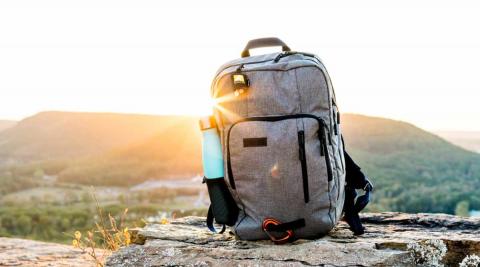8 Backpack Essentials for a Mountain Hike
Never forget the five P’s: Proper Planning Prevents Poor Performance.
If you want to be as prepared as possible for a day in the mountains then read on…
Have you got an exciting adventure planned? After a long week at work, I bet you can’t wait to get out in the mountains again, test your stamina, get some fresh air and take in some awesome mountain views!
But do you give proper thought to what you actually take with you in your backpack for the day? Or do you spend too much time preparing? Are you conscious of how heavy your backpack is and want to take only essential items up a mountain?

What are Backpack Essentials?
For any hike, the following items are considered essential bits of kit for your backpack and you should make space and weight allowance for them. This is the minimal amount to carry on an easy summer hike:
- A means of navigation, whether that’s a map and compass, a mobile phone or both. If it’s the former, ensure your compass is accurate and you have picked up the correct map for the area you plan to visit. Keep a good hold of it in strong winds! If you’ll be relying on your mobile phone, ensure it has sufficient charge, carry a battery pack, and bear in mind that signal can be intermittent in the mountains so ensure any app you’re using works offline. Check out https://shop.ordnancesurvey.co.uk/apps/os-maps-subscriptions/ Or https://www.outdooractive.com/en/
- Food and drink – lunch, snacks (bring more than you think you’ll need), and enough water to keep you hydrated. If you want to pack lightly and you know you’ll be passing streams, you can also fill up with water as you ascend (this is at your own risk – the higher up you go, the safer the water is likely to be!) Bring water purifying tablets if unsure.
- Waterproof clothing – at the very least a waterproof jacket.
- Spare clothing – no matter how pleasant the forecast looks, it can change very quickly and will always feel colder on summits so bring an extra layer in your backpack.
- Sun protection if it’s hot (or even if it’s cold actually) don’t underestimate how easy it is to catch the sun. It can be blinding (literally) in snowy conditions. Bring sunblock and sunglasses or risk looking like a cooked maritime crustacean.
- First-aid kit in case of an emergency. An emergency blanket weighs nothing but could make all the difference if you are hurt and immobile. Also, don’t forget to bring any prescription medication in your backpack.
- Whistle (many backpacks come with one built-in).
- Headtorch – Any walk could take longer than you were expecting, and this is all about being prepared for the unexpected. Make sure you have sufficient battery power.
What about walking in winter?
Winter hiking is a different ballgame. The weather, conditions, and environment can be harsh and unpredictable. In addition to all the above you’re going to need (amongst other things):
- Ice-axe and crampons – check conditions before you go but if you’re not sure it’s always better to be prepared. – Make sure you have had proper training on how to use these before you set off
- Bivvy bag – will provide shelter anywhere in case of an accident.
Ben Nevis Winter Guided Training and Ascent
Some non-essential items that are nice to have in your backpack:
- Binoculars
- Tissues
- Spare hair bobble
- Walking poles
- Spare boot laces
- Gaiters
- Insect repellent

Remember, it doesn’t matter how prepared you are for the hike, you should research the route before going, check the weather forecast and stick to routes within your capabilities. You should always tell someone where you’re going and be able to use your method of navigation effectively.
Article Written by Belinda Hodder.








